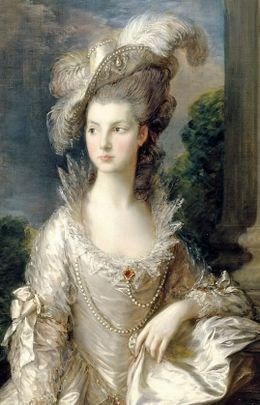Annotation:Mrs. Graham of Ballgown's Reel: Difference between revisions
No edit summary |
No edit summary |
||
| (One intermediate revision by the same user not shown) | |||
| Line 1: | Line 1: | ||
{{TuneAnnotation | {{TuneAnnotation | ||
|f_annotation=[[File:Mrs.Graham.jpg|right|260px|thumb|The Honourable Mrs. Graham, by Thomas Gainsborough, 1777]]'''MRS. GRAHAM OF BALGOWAN'S REEL'''. AKA - "Mrs. Graham of Ballgown's Reel." Scottish, Reel. D Mixolydian. Standard tuning (fiddle). AABCCD. Composed by [[biography:Daniel Dow]], first printed in his collection c. 1775 (p. 8). It also was printed by the Gows and by Kirkmichael, Perthshire, fiddler and composer Robert Petrie (in his '''Second Collection of Strathspey Reels and Country Dances''', 1796). The beautiful and amiable Mrs. Graham was Mary Cathcart, sister of Jane, the Duchess of Athole, | |f_annotation=[[File:Mrs.Graham.jpg|right|260px|thumb|The Honourable Mrs. Graham, by Thomas Gainsborough, 1777]]'''MRS. GRAHAM OF BALGOWAN'S REEL'''. AKA - "Mrs. Graham of Ballgown's Reel." Scottish, Reel. D Mixolydian. Standard tuning (fiddle). AABCCD. Composed by [[biography:Daniel Dow]], first printed in his collection c. 1775 (p. 8). It also was printed by the Gows and by Kirkmichael, Perthshire, fiddler and composer Robert Petrie (in his '''Second Collection of Strathspey Reels and Country Dances''', 1796). The beautiful and amiable Mrs. Graham was Mary Cathcart, sister of Jane, the Duchess of Athole, second daughter of the 9th Lord Cathcart, and a sister to his successor. She married politician, army officer and aristocrat Thomas Graham of Balgowan, afterwards Lord Lynedoch, at age 16 in a double wedding with her older sister Jane, who married John Murray, 4th Duke of Atholl. "Jane," wrote Lord Cathcart, "has married, to please herself, John, Duke of Atholl, a peer of the realm; Mary has married Thomas Graham of Balgowan, the man of her heart, and a peer among princes." Gainsborough painted her portrait three times, producing most famously "The Honourable Mrs. Graham" in 1777, a few years after her marriage to Thomas. She died in 1794, although Thomas survived until 1843 (and hailed as the hero of Barossa). | ||
|f_printed_sources=Carlin ('''The Gow Collection'''), 1986; No. 444. Robert Petrie ('''Second Collection of Strathspey Reels and Country Dances'''), 1796; p. | <br> | ||
<br> | |||
After nearly two decades Mary Graham's health began to decline, and in the spring of 1792, on the recommendation of her medical adviser, she went to the south of France with her husband and sister. However, during the voyage she died off the coast near Hyères, France, on 26 June 1792. Her sorrowing husband hired a barge to take the casket to Bordeaux but near Toulouse a group of French soldiers opened the coffin and disturbed the body. He closed the casket and returned home to deposit her remains in a mausoleum, which he built in the churchyard of Methven. Graham would himself be laid in the same tomb fifty years later. | |||
|f_printed_sources=Carlin ('''The Gow Collection'''), 1986; No. 444. Robert Petrie ('''Second Collection of Strathspey Reels and Country Dances'''), 1796; p. 23. Robert Ross ('''Choice Collection of Scots Reels or Country Dances & Strathspeys'''), Edinburgh, 1780; p. 39. | |||
|f_tune_annotation_title=https://tunearch.org/wiki/Annotation:Mrs._Graham_of_Ballgown's_Reel > | |f_tune_annotation_title=https://tunearch.org/wiki/Annotation:Mrs._Graham_of_Ballgown's_Reel > | ||
}} | }} | ||
------------- | ------------- | ||
Latest revision as of 23:24, 24 May 2023
X:1 T:Mrs. Graham of Balgowan’s Reel M:C| L:1/8 R:Reel B:Robert Ross – Choice Collection of Scots Reels or Country Dances B:& Strathspeys (Edinburgh, 1780, p. 39) Z:AK/Fiddler’s Companion K:D d|ADFD (FA2)d|GBFA =cEEd|ADFD FAGB|A(gTf>e) dD D:| g|fdad fada|g=cec egcg|fdad ^ceA=c|BGE^c dDDg| fdad fada|g=cec efga|fd^ce dFAF|E(gTf>e) dDD|| |:d|AdFd DdAd|BdAd =cEEd|AdFd DdAd|GBA^c dDD:| d|Adfd gefd|edfd eg=ce|dAfd eAag|fdec dDDd| Adfd edfd|gefd cdeg|fdBd AdGd|FdEg fdd||

After nearly two decades Mary Graham's health began to decline, and in the spring of 1792, on the recommendation of her medical adviser, she went to the south of France with her husband and sister. However, during the voyage she died off the coast near Hyères, France, on 26 June 1792. Her sorrowing husband hired a barge to take the casket to Bordeaux but near Toulouse a group of French soldiers opened the coffin and disturbed the body. He closed the casket and returned home to deposit her remains in a mausoleum, which he built in the churchyard of Methven. Graham would himself be laid in the same tomb fifty years later.

